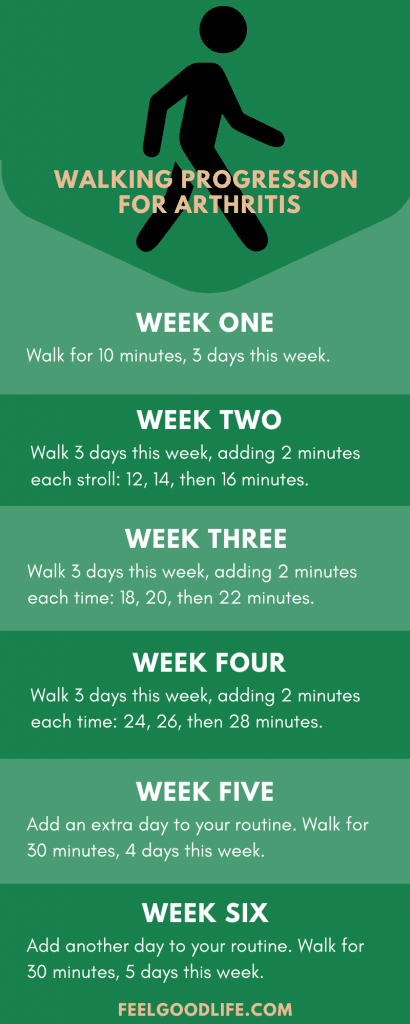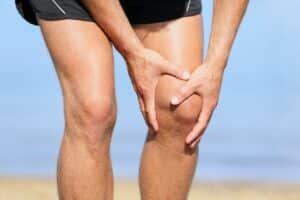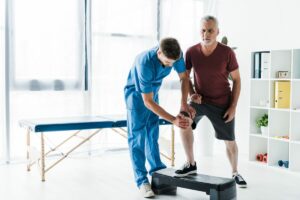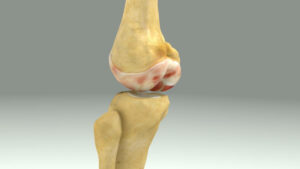Free download: Top 10 Natural & Easy Remedies for Joint Pain from Home. Learn these helpful remedies.
Wondering if walking is really good for your arthritis? If so, then why is it the joints can hurt while walking?
If walking is good for arthritis, how can you manage your arthritis pain in a way to stay active on a regular basis? This in-depth article covers it all on walking with arthritis, and more!
Walking is one of the best forms of exercise you can do when you have arthritis. In fact, walking helps to mobilize joint fluid (called synovial fluid) to lubricate joints and provide nutrients to cartilage.
Additionally, a regular walking program is a great form of low impact exercise, which is usually nicer on the joints compared to higher impact activities, such as jogging.
Like anything though, too much of something isn’t necessarily a good thing. That’s why it’s so important to learn what your body can and can’t handle, such as with a walking program. How much is too much? That’s what we’ll help you figure out!
It all comes down to learning how to include a walking program without irritating your arthritis symptoms.
Table of Contents
A Closer Look at Arthritis
Arthritis is a term thrown around a lot. It’s especially used as we get older and start to feel more regular joint pain, but what exactly is arthritis?
Arthritis is in fact a common problem that affects the joints as we age. It will usually lead to pain and inflammation in the joints. Keep in mind though, other conditions besides natural aging can cause various types of arthritis.
With arthritis we tend to lose the natural supportive structures present within the joint that help to cushion and protect it. With loss of these supportive structures, the joints tend to become more susceptible to compressive and friction forces, subsequently making your pain feel worse.
Over time, this will gradually begin to affect your activity level more and more.
Types of Arthritis
It’s important to understand that the term arthritis is a bit of an umbrella term, as there are actually many forms of arthritis. There are actually over 100 various joint conditions that can be labeled as arthritis.
Let’s take a look at some of the most common types of arthritis and their usual symptoms.
1. Osteoarthritis (OA):
Osteoarthritis is most common. OA develops as the joint cartilage begins to wear and break down. This will lead to bone-on-bone changes within the joint. OA most commonly occurs in the knees, hips, hands, and can even occur in the spine.
You’ll usually experience joint aching, stiffness and swelling. Pain is usually worse after prolonged rest or when first getting up in the morning.
While more than one joint can be affected by OA, it doesn’t usually affect multiple joints in the body, such as inflammatory arthritic conditions.
2. Rheumatoid arthritis (RA):
Rheumatoid arthritis (RA) is a chronic inflammatory condition that occurs when the immune system goes and breaks down the synovial lining in the joints. This can contribute to pain, swelling and joint deformity. Other parts of the body and body systems can also be affected by RA.
Due to the inflammation you may notice warmth and tenderness in the joints. RA can also cause stiffness, especially after being sedentary for prolonged periods. RA commonly affects multiple joints in the body.
3. Psoriatic Arthritis:
Psoriatic arthritis isn’t too different from RA with its symptoms, but it may not affect as many joints as RA. It’s an inflammatory arthritis that can lead to inflammation and sometimes joint deformity. This type of arthritis is commonly linked with a skin condition called psoriasis. Stiffness is also common with psoriatic arthritis.
4. Gout:
Gout is another example of an inflammatory arthritis. It usually will affect one joint versus multiple, most commonly affecting the big toe joint. Gout is usually caused by a build-up of uric acid crystals in the affected joint. This can cause high levels of pain, swelling, warmth and stiffness in the joint.
5. Ankylosing spondylitis (AS):
Ankylosing spondylitis (AS) is an arthritis that primarily affects the spine. Wearing and natural fusion of the affected joints typically occurs as this type of arthritis progresses. This can lead to pain, stiffness, inflammation, and a poor posture.
These, again, are just a few examples of common types of arthritis that you may be dealing with as you begin your walking program.
So now that we know more about arthritis itself, let’s take a look at why walking can actually help your arthritic symptoms.
Benefits of Walking with Arthritis
Plenty of individuals have asked, “Is walking good for arthritis in the knee or hip?” and here is the research designed to find the answer. Scientists have found these 10 common benefits of walking with arthritis:
1. Improved Circulation
The simple workout of walking wards off heart disease, strengthens the heart rate, and lowers blood pressure. Women who participate in a regular walking routine 30 minutes a day can reduce their risk of stroke by 20%, and by 40% when they stepped up the pace to a brisk walk, according to researchers at the Harvard School of Public Health in Boston.
2. Strengthen Bones
Walking can stop the loss of bone mass for those with osteoporosis, according to Michael A. Schwartz, MD, of Plancher Orthopedics & Sports Medicine in New York. In fact, one study of post-menopausal women found that 30 minutes of walking each day reduced their risk of hip fractures by 40%.
3. Increased Lifespan
Research finds that people in their fifties and sixties who participate in a regular exercise program are 35% less likely to die over the next eight years than their non-walking counterparts. That number shoots up to 45% less likely for those who have underlying health conditions. This is likely related to the many health benefits we’re discussing when you participate in a regular walking workout.
4. Improved Mood
Walking releases natural painkilling endorphins to the body. A California State University, Long Beach, study showed that the more steps people took during the day, the better their moods were. Let’s be honest, going for a nice walk feels good and is a great way to address stress. Stress absolutely can affect pain in the body, so less stress is always better.
5. Weight Loss
A brisk 30-minute walk burns 200 calories and increases your resting metabolism. Over time, calories burned can lead to pounds dropped. Losing weight when needing and maintaining a healthy weight is very important to avoid placing additional stress and strain on your joints.
6. Strengthen Muscles
Walking is a great way to build muscle strength. It tones your leg and abdominal muscles – and even arm muscles on occasion. This increases your range of motion, shifting the pressure and weight from your joints to your muscles.
7. Improved Sleep
Waling not only provides energy for the day but also puts us to rest in a better state. Studies found that women, ages 50 to 75, who took one-hour morning walks, were more likely to relieve insomnia than women who didn’t walk at all.
8. Joint Support
The majority of joint cartilage has no direct blood supply. It gets its nutrition from joint fluid that circulates as we move. Movement and compression from walking “squishes” the cartilage, bringing oxygen and nutrients into the area.
9. Reduced Mental Decline
A study from the University of Virginia Health System in Charlottesville found that men between the ages of 71 and 93 who walked more than a quarter of a mile per day had half the incidence of dementia and Alzheimer’s disease than those who walked less.
10. Improved Breathing
When walking, your breathing rate increases, causing oxygen to travel faster through the bloodstream. This constant filtration of nutrients helps to eliminate waste products, improve energy levels, and increases the ability to heal and reduce pain..
Along with these 10 powerful benefits, aerobic walking and resistance exercise programs have been shown to reduce the incidence of disability for people who are older than 65 and have symptomatic osteoarthritis (OA).
For those living in near-constant pain every day, where do they start?
Before You Start a Walking Program with Arthritis
Before starting a new exercise program, talk with your doctor. They’ll help you to consider the current limits of your joints and provide ways to work within those limits.
Your doctor or a physical therapist can help create a personalized walking plan that gives you the most benefit without aggravating your joint pain.
However, here are some additional tips for preventing pain when walking with arthritis:
Step 1: Pick the Right Walking Gear
To prep for your walk, be sure to choose the right walking shoes. The right shoes should be comfortable shoes, but also have proper arch support, a firm heel, and thick flexible soles to cushion your feet and absorb shock. The toe box should be roomy, and not too long.
As well, walking poles may relieve pressure on the joints and assist with balance and stability.
Lastly, to stay hydrated, drink a few cups of water 15 minutes before you start walking, and another few cups after you cool down.
If you’re going for a longer walk, keep a water bottle handy and have a drink of water every 20 minutes or so while you exercise.
Step 2: Start Slowly
Don’t rush into a new type of physical activity without properly allowing yourself time to adjust to this new type of movement. When it comes to a walking program, begin slow and build yourself up. If you don’t, you could make your joint pain worse.
You might do five minutes a day the first week, and then increase your time or distance a few minutes the next week. Your doctor or physical therapist can help structure a program that’s right for you. Or, you can follow this gentle progression:

Step 3: Build-Up to 150 Minutes Per Week
The above breakdown plays into this tip as well. Performing 150 minutes of activity works out to 30 minutes a day, five days a week of moderate-intensity aerobic exercise.
You can even split that time into 10-minute blocks if you struggle with chronic fatigue.
Step 4: Adjust Your Routine as Needed
Listen to your body. Arthritis can be frustrating because some days it may feel worse than others. Why is this?
It’s not always well understood why your arthritic pain can fluctuate, but some possible reasons might include a change in weather (especially if it becomes much colder than you’re used to!), fighting an illness that’s put you down for the count and kept you more inactive, or sometimes overuse and doing too much can irritate your arthritis.
You’ll learn what makes your arthritis tick, but it’s a process.
Listen to your body. If you wake up with a lot of stiffness, gentle exercises, such as simple stretching or range of motion exercises and other strategies may be helpful, but going for a longer walk may be more challenging.
Joint pain varies day to day, so it’s important to modify your walking distance and time based on how you are feeling.
Remember though, a little bit of something is better than a whole lot of nothing! If your joint pain is hurting too much to go for a longer walk, see if you can do a shorter one. Switch up your usual pace to accommodate your pain and slow it down if needed.
If it still just isn’t working, you may need to take the day off and focus on some gentle stretches and resting.
Step 5: Move Gently
Move your joints gently at first to ease your body into movements. You might begin with range of motion exercises or other dynamic motions for five to 10 minutes as a warm-up before you begin an aerobic exercise.
Here are a two examples of easy, gentle movements to do for warming up before your walk:
- Heel Raises
- Standing with your feet side by side, but slightly apart, slowly raise your heels up and down from the ground. Repeat 10-15x.
- Marching
- Feel free to march standing or sitting. Lift one knee up at a time, alternating sides for 10-15x.
When you do start walking, focus on landing softly with each stride.
Don’t feel like you need to begin a walking workout with brisk walking. Start at a slower pace initially. Once you’ve been able to determine how your body responds to this initial slower pace, and it doesn’t cause more pain, you can gradually begin to walk faster, but still keep a comfortable pace.
Step 6: Stop If Anything Hurts
Take a break if your joints start to ache — sit on a bench for a minute or two and engage in some easy breathing before continuing. If the pain is sharp and stabbing, or you feel any new joint pain, it’s time to stop for the day.
Talk to your doctor about what pain is normal and when it’s a sign of something more serious.
The above are great strategies to begin your walking regimen.
But for those still wondering, “Is walking good for arthritis in the hip or knee, specifically? I’m not sure my OA pain can take this…” Try following the below strategies for managing your arthritic pain while walking.
Managing Your Pain When Walking for Arthritis

You can relieve your OA pain with some smart moves before and after your walk. The key is to perform these activities regularly, not just when in pain.
Try including one of these strategies for a few weeks on a regular basis and see how you feel.
1. Walk When You Feel Good
Plan on walking when you usually feel good. Are your joints stiff in the morning? Head out in the afternoon. If you take a pain reliever, go for a stroll when it kicks in.
2. Warm-Up
Take a warm shower, apply warm washcloths, or a heating pad in the half hour before your walk. The heat relaxes your joints and helps circulate blood to your muscles before any movement is necessary.
3. Massage It Out
Give yourself a massage. Gently rub the muscles around your aching joint 10 minutes prior to your walk. This boosts blood flow to the area.
4. Ice Those Joints
After you exercise, ice your joints for up to 20 minutes. This can relieve any swelling as well as excess inflammation signals causing your pain.
5. Stay the Course
Remember, consistency is key to reducing joint pain when walking. But if you still can’t seem to resist the call of the couch, try these steps to boost your motivation:
- Track Your Progress: You can use a journal or exercise app to record how far, how long, and how often you walk. On top of keeping yourself accountable, it helps to remember where you’re at in your journey.
- Wear a Pedometer: Research suggests that keeping count of your steps encourages you to move more. Make every day a new challenge to keep walking farther.
- Join Forces with Friends: Meeting up with others can make walking more fun. Walking groups also hold you accountable, so you’re less likely to skip a workout. Find a friend to buddy up with, or join a local walking group.
Activities to Avoid with Arthritis Pain
We’ve talked a lot about how to walk with arthritis and why it can be beneficial for your arthritis, but you also may be wondering what activities you should avoid with arthritis pain.
High impact sports and activities will usually place excessive stress and strain on the joints. These activities will usually make joint pain feel worse.
Examples of higher impact activities include running or jogging, advanced athletic competitions such as a Savage Race, and contact sports such as soccer, basketball, and football.
Key Points
The key is to emphasize and encourage activity, but low impact exercise that won’t make your pain worse.
While walking for arthritis may look different for everyone, the above strategies can be used, in conjunction with your doctor, to help start you on the right path towards an active, pain-free lifestyle!
FAQs:
Should I wear a brace while walking if I have knee arthritis pain?
You absolutely can. Sometimes for longer duration standing activities, wearing a flexible brace can give additional support and stability to the arthritic joint.
Just try to avoid wearing it all the time, otherwise your own muscles may start to get a little lazy and not want to work the way they should to support the joint.
Does everyone with arthritis end up needing a joint replacement?
Not necessarily.
A joint replacement is usually necessary in severe cases of osteoarthritis that has advanced to the point that the individual is experiencing constant, debilitating pain and significant functional limitations. A consult with an orthopedic surgeon will help to determine if a joint replacement is something necessary for your osteoarthritis.
Can I do strength training exercises with arthritis pain?
The right kind of strength training can be very beneficial to support an arthritic joint and even help to slow the process of arthritis. Always make sure that any exercise you’re doing doesn’t make your pain worse.

















14 Responses
You are doing great & I am enjoying everything you say & do; I have only one grabbing pain in my right groin today & it has me stopped. I am icing & easing up on my activities right now. 86 is some good days & some not so good days.
Darlene, I'm glad that you're enjoying our exercises. I hope you're finding them helpful. That's great that you're listening to your body and taking a break when it's needed. Thank you for reading!
Darlene, thank you so much for your feedback! We appreciate it, and I'm glad that you're enjoying our content. That's great that you are listening to your body and not pushing yourself too hard. I hope you have a lot more good days than bad days ahead of you!
I am so happy with this article! I have always felt I was doing damage by walking and my husband was no help in this area. I’m so happy you also stress the right walking shoes as I recently suffered from Achilles tendinitis which was no fun! It was caused by doing my walking in my house just wearing slippers with no support. Any suggestions on brands of shoes that will be helpful for my old joints?
Sandie, sneakers can get complicated! Speaking with a PT friend, Brooks is a good brand to help with joints.
My knees are bone on bone & I have been told knee replacement is the only help. Any suggestions for NOT wanting that & still have a desire to eliminate the man of even a five minute walk or standing?
Hi Sharon! You're at the right place! My whole goal is helping people avoid surgery. I have lots of articles on knee pain with exercises you can start doing to improve your knee stability and decrease pain. I recommend you start here: https://www.feelgoodlife.com/knee-exercises-from-bed/
If those exercises help, you will be a good candidate for my Feel Good Knees 6 weeks program.
Hi Todd
I have a bakers cyst in my knee with some arthritis. Ive had Physio, who told me to do 30 squats a day with a towel between my legs. You have said squats are not good for this. Why is my Physio telling me to do squats.?
Thanks
Cheers
Cathy
Hi Catherine! Thanks for asking. In my experience with treating knee pain (baker cysts included), squats are not the first exercise I recommend for most people. However, it is something I have my clients work towards. So trust your physio! If they think you are ready for squats, then go ahead and give it a try. If you find it isn't helping, be sure to check out my other exercises for knee pain and see if that helps instead.
I recently ordered the knee book, and received it. I thought I’d ordered the other book/books that deal with all joints but haven’t received. Can you please check the status?
Thank you,
Marilyn Chapple
512-461-1169
mkdchapple@gmail.com
Hi Marilyn! Please email my support team at todd@feelgoodlife.com. We will be happy to look into this for you!
Hi Todd, i bought a bunch of your programs . my wife has severe knee pain. dr's say cartiledge is gone. walking is very difficult for her. where/how should she start? thanks, bob
Hi Bob! My Feel Good Knees program is the perfect place to start. I recommend that she start with the phase one exercises. Normally, I suggest doing the exercises daily but for her, I would say start off with every other day. Icing after the exercises will also help with any pain. If you need access to your download links, please send an email to my support team at todd@feelgoodlife.com.